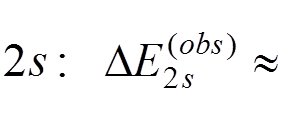The absorption of a photon can be considered in the same way as the emission. It can be shown that
 .
.
Bethe’s evaluation of the Lamb shift
Electron self energy in non-relativistic
approximation
We consider a non-relativistic H-like atom. The interaction of the atomic electron with the quantized radiation field in the electric-dipole approximation is described by the operator
 .
.
Let us evaluate
the energy shift of atomic level ![]() due to this
interaction. To first order, one easily finds
due to this
interaction. To first order, one easily finds
 .
.
To second order, we have (“self energy”)


 ,
,
we obtain
 .
.
The angular integration over photon momentum directions and the summation over photon polarization is performed by formula
 .
.
 .
.
Introducing
![]() , we have
, we have
 .
.
This
integral diverges linearly at high ![]() . However, we may argue that we
can not take too seriously the contributions from virtual photons of energy
. However, we may argue that we
can not take too seriously the contributions from virtual photons of energy
 ,
,
since our consideration is non-relativistic. So, we replace
 ,
,
where  .
.
Mass renormalization
Let us
consider the self energy for a free non-relativistic electron. Taking into
account that, for a free electron, non-diagonal matrix elements of ![]() vanish, we get
vanish, we get
 ,
,
where ![]() is the momentum of the free
electron. This
integral is also linearly divergent as
is the momentum of the free
electron. This
integral is also linearly divergent as  .
.
Since,
we can not switch off the electromagnetic interaction,  can not be separated from the usual kinetic
energy. In fact,
the observable kinetic energy is the sum of the kinetic energy of the bare
electron
can not be separated from the usual kinetic
energy. In fact,
the observable kinetic energy is the sum of the kinetic energy of the bare
electron 
where
 is the bare electron mass (the
electromagnetic interaction is switched off) and
is the bare electron mass (the
electromagnetic interaction is switched off) and  .
.
The observed (physical) electron mass is defined by

 .
.
It follows
 .
.
Let us now return to the atomic energy shift.
When we
solve the Schroedinger equation, to find the unperturbed energy we use  (which includes
(which includes  ) instead of
) instead of  .
.
Therefore, when we calculate the energy shift due to the interaction with the radiation field, we must subtract the term

to avoid any double accounting. In other words, we must use in the Schroedinger equation

 .
.
The observable energy shift is

 .
.
In other words, what is observable is the difference of the bound-electron self energy and the free-electron self energy.
We have




we obtain



![]()
Taking into account that

 ,
,
we get

 .
.
This
expression still diverges as  but the divergence is
logarithmic. In the relativistic theory this divergence vanishes. We can obtain a good estimate for
but the divergence is
logarithmic. In the relativistic theory this divergence vanishes. We can obtain a good estimate for  by putting
by putting 
( is not very sensitive to the choice of
is not very sensitive to the choice of  , if
, if  ).
).
Finally, we obtain (Bethe, 1947)

 ,
,
or using
 ,
,
we have

 .
.
The numerical evaluation of this term yields
 1040 MHz
1040 MHz
 0
0
This energy splitting is in a good agreement with the first experiment by Lamb and Retherford (1947):
 1062(5) MHz .
1062(5) MHz .
Quantization of the electron-positron field
In relativistic quantum mechanics the one-electron atom is described by the Dirac equation
 ,
,
where
 .
.
To formulate a consequent relativistic theory of electrons and positrons, we must quantize the Dirac field
 ,
,
where  are solutions of the stationary
Dirac equation
are solutions of the stationary
Dirac equation
Уважаемый посетитель!
Чтобы распечатать файл, скачайте его (в формате Word).
Ссылка на скачивание - внизу страницы.